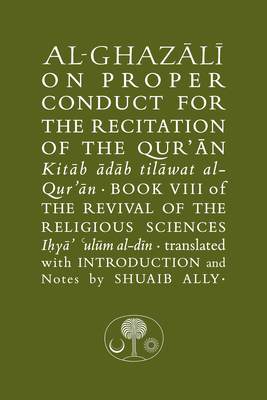
Part of Series
Al-Ghazali on Proper Conduct for the Recitation of the Qur'an is the eighth chapter of Abu Hamid al-Ghazali's magnum opus, the Revival of the Religious Sciences (Ihya' 'ulum al-din), a monumental work of classical Islam written by the renowned theologian-mystic Abu Hamid al-Ghazali (d. 1111). This chapter of the Revival deals with the fundamental importance of the Qur'an and its role in an individual's salvation. After establishing the pre-eminence of the Qur'an and of those who are devoted to its recitation, Ghazali outlines the outer proper conduct for its recitation: the condition of the reciter, the quantity of recitation, properly apportioning the Qur'an, method of writing, measured recitation, crying, taking into account the rights of verses, what to say at the beginning of one's recitation, reciting aloud and beautifying one's recitation, and embellishing it by modulating one's voice. Ghazali then proceeds to identify the inner actions while reciting the Qur'an: understanding the grandeur and stature of the Speech, reverence for the Speaker, presence of mind and not letting one's mind wander, reflection, deeper understanding, ridding oneself of obstacles to understanding, specification, being affected, ascension and divestment. In the fourth and final chapter, Ghazali deals with an issue which continues to be a source of contention today: the problem of the permissibility of generating new interpretations of the Qur'an. Ghazali convincingly argues that a proper engagement with the Qur'an is not restricted by the boundaries of earlier interpretations. This volume also includes a translation of Imam Ghazali's own Introduction to the Revival of the Religious Sciences which gives the reasons that caused him to write the work, the structure of the whole of the Revival and which places each of the chapters in the context of the others.
Author

أبو حامد الغزالي Muslim theologian and philosopher Abu Hamid al-Ghazali of Persia worked to systematize Sufism, Islamic mysticism, and in The Incoherence of the Philosophers (1095) argued the incompatibility of thought of Plato and Aristotle with Islam. Born in 1058, Abū Ḥāmid Muḥammad ibn Muḥammad al-Ghazālī ranked of the most prominent and influential Sunni jurists of his origin. Islamic tradition considers him to be a Mujaddid, a renewer of the faith who, according to the prophetic hadith, appears once every century to restore the faith of the ummah ("the Islamic Community"). His works were so highly acclaimed by his contemporaries that al-Ghazali was awarded the honorific title "Proof of Islam" (Hujjat al-Islam). Al-Ghazali believed that the Islamic spiritual tradition had become moribund and that the spiritual sciences taught by the first generation of Muslims had been forgotten.[24] That resulted in his writing his magnum opus entitled Ihya 'ulum al-din ("The Revival of the Religious Sciences"). Among his other works, the Tahāfut al-Falāsifa ("Incoherence of the Philosophers") is a significant landmark in the history of philosophy, as it advances the critique of Aristotelian science developed later in 14th-century Europe. أبو حامد محمد الغزّالي الطوسي النيسابوري الصوفي الشافعي الأشعري، أحد أعلام عصره وأحد أشهر علماء المسلمين في القرن الخامس الهجري،(450 هـ - 505 هـ / 1058م - 1111م). كان فقيهاً وأصولياً وفيلسوفاً، وكان صوفيّ الطريقةِ، شافعيّ الفقهِ إذ لم يكن للشافعية في آخر عصره مثلَه.، وكان على مذهب الأشاعرة في العقيدة، وقد عُرف كأحد مؤسسي المدرسة الأشعرية في علم الكلام، وأحد أصولها الثلاثة بعد أبي الحسن الأشعري، (وكانوا الباقلاني والجويني والغزّالي) لُقّب الغزالي بألقاب كثيرة في حياته، أشهرها لقب "حجّة الإسلام"، وله أيضاً ألقاب مثل: زين الدين، ومحجّة الدين، والعالم الأوحد، ومفتي الأمّة، وبركة الأنام، وإمام أئمة الدين، وشرف الأئمة. كان له أثرٌ كبيرٌ وبصمةٌ واضحةٌ في عدّة علوم مثل الفلسفة، والفقه الشافعي، وعلم الكلام، والتصوف، والمنطق، وترك عدداَ من الكتب في تلك المجالات.ولد وعاش في طوس، ثم انتقل إلى نيسابور ليلازم أبا المعالي الجويني (الملقّب بإمام الحرمين)، فأخذ عنه معظم العلوم، ولمّا بلغ عمره 34 سنة، رحل إلى بغداد مدرّساً في المدرسة النظامية في عهد الدولة العباسية بطلب من الوزير السلجوقي نظام الملك. في تلك الفترة اشتُهر شهرةً واسعةً، وصار مقصداً لطلاب العلم الشرعي من جميع البلدان، حتى بلغ أنه كان يجلس في مجلسه أكثر من 400 من أفاضل الناس وعلمائهم يستمعون له ويكتبون عنه العلم. وبعد 4 سنوات من التدريس قرر اعتزال الناس والتفرغ للعبادة وتربية نفسه، متأثراً بذلك بالصّوفية وكتبهم، فخرج من بغداد خفيةً في رحلة طويلة بلغت 11 سنة، تنقل خلالها بين دمشق والقدس والخليل ومكة والمدينة المنورة، كتب خلالها كتابه المشهور إحياء علوم الدين كخلاصة لتجربته الروحية، عاد بعدها إلى بلده طوس متخذاً بجوار بيته مدرسةً للفقهاء، وخانقاه (مكان للتعبّد والعزلة) للصوفية.


